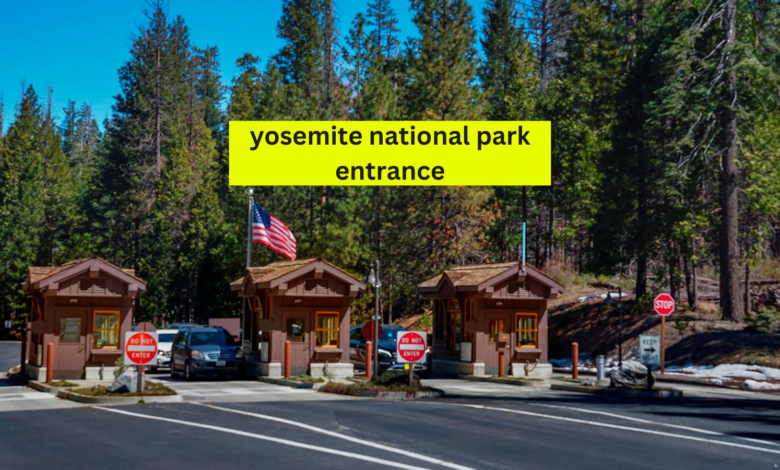yosemite national park entrances best 6 in 2023

Yosemite National Park is a treasure trove of natural beauty, attracting nature enthusiasts, hikers, climbers, and photographers from around the world. To access the park, you can choose from several entrances, each offering its own unique experience and access to different parts of the park. Let’s delve into the details of these entrances and discover the wonders that await within Yosemite’s boundaries.
Yosemite National Park: A Brief Overview
Yosemite National Park, established in 1890, is one of the oldest national parks in the United States. It is famous for its dramatic granite cliffs, pristine lakes, ancient giant sequoia trees, and abundant wildlife. The park is divided into several areas, each with its own distinct features and attractions. Yosemite Valley, Glacier Point, Tuolumne Meadows, Mariposa Grove, and Hetch Hetchy are among the most popular destinations within the park.
Choosing the Right Entrance
When planning your trip to Yosemite National Park, it’s important to consider which entrance suits your interests and desired destinations within the park. Here are the main entrances to Yosemite and the areas they provide access to:
1. Arch Rock Entrance
The Arch Rock Entrance, also known as the Highway 140 Entrance, is located on the western boundary of Yosemite. This entrance is the closest to Mariposa Grove, home to the largest stand of giant sequoias in Yosemite. It offers convenient access to Yosemite Valley, the heart of the park, where you can marvel at iconic landmarks like Half Dome, El Capitan, and Bridalveil Fall.
2. Big Oak Flat Entrance
The Big Oak Flat Entrance, situated along Highway 120, is a popular gateway to Yosemite National Park. It provides access to the northern part of the park and offers stunning views of granite formations and majestic forests. From this entrance, you can explore Tuolumne Meadows, renowned for its alpine beauty and pristine wilderness.
3. South Entrance
The South Entrance, located near the town of Oakhurst, grants access to the southern portion of Yosemite National Park. This entrance is the closest to Wawona, where you can visit the historic Wawona Hotel and explore the picturesque Mariposa Grove. The South Entrance also provides a direct route to Yosemite Valley.
4. Tioga Pass Entrance
The Tioga Pass Entrance, situated along Highway 120, is the highest highway pass in California. This entrance offers breathtaking views as you ascend into the alpine regions of Yosemite. Tioga Road, accessible from this entrance, provides access to high-country destinations like Tuolumne Meadows, Tenaya Lake, and Olmsted Point.
5. Hetch Hetchy Entrance
The Hetch Hetchy Entrance is the gateway to the lesser-known but equally stunning Hetch Hetchy Valley. This entrance is located on the park’s western boundary and provides access to a remote and tranquil area with scenic hiking trails and the Hetch Hetchy Reservoir.
6. Glacier Point Entrance
The Glacier Point Entrance, accessible from Highway 41, offers awe-inspiring panoramic views of Yosemite Valley, Half Dome, and the surrounding high country. This entrance is particularly popular during the summer months when Glacier Point Road is open, allowing visitors to access the iconic Glacier Point overlook.
Other Access Points
In addition to the main entrances mentioned above, there are several other access points scattered throughout Yosemite National Park. These include the Crane Flat Entrance, the Big Oak Flat Information Station, the Evergreen Road Entrance, and the Yosemite Valley Shuttle System. These access points provide additional options for exploring the park and accessing different areas.
Exploring the Park: Must-Visit Destinations
Yosemite National Park offers a multitude of must-visit destinations that showcase its natural wonders. Here are a few highlights you won’t want to miss:
– Yosemite Valley: The crown jewel of the park, Yosemite Valley is home to towering granite cliffs, meadows, waterfalls, and the Merced River. It offers breathtaking views of iconic landmarks and numerous hiking trails for all skill levels.
– Mariposa Grove: Located near the southern entrance, Mariposa Grove is a sanctuary for giant sequoia trees, including the famous Grizzly Giant and California Tunnel Tree. Take a leisurely stroll among these ancient giants and marvel at their magnificence.
– Glacier Point: For unparalleled views of Yosemite Valley and the high country, head to Glacier Point. This iconic overlook offers sweeping vistas of Half Dome, Yosemite Falls, and the surrounding wilderness.
– Tuolumne Meadows: Situated at an elevation of 8,600 feet, Tuolumne Meadows is a subalpine meadow renowned for its wildflower displays, alpine lakes, and granite domes. It serves as a starting point for numerous hiking and backpacking adventures.
Accommodations and Camping Options
Yosemite National Park offers a range of accommodation options to suit every traveler’s needs. From luxurious lodges to rustic cabins and campgrounds, there are plenty of choices available. Some of the popular lodging options include The Ahwahnee, Yosemite Valley Lodge, and Curry Village. For camping enthusiasts, the park offers several campgrounds, both reservable and first-come, first-served, providing an opportunity to immerse yourself in nature.
Activities and Outdoor Adventures
Yosemite National Park is a haven for Adventurous travelers, offering a wide array of activities and adventures. From hiking and backpacking to rock climbing, fishing, birdwatching, and photography, there is something for everyone. Explore the park’s extensive trail network, challenge yourself on the iconic rock formations, or simply relax and soak in the natural beauty that surrounds you.
Wildlife and Nature Observation
Yosemite is home to a diverse range of wildlife species, including black bears, mule deer, coyotes, bobcats, and numerous bird species. As you explore the park, keep an eye out for these incredible creatures in their natural habitats. Remember to maintain a safe distance and follow park guidelines to ensure the well-being of both the animals and yourself.
Safety Tips and Guidelines
When visiting Yosemite National Park, it’s important to prioritize safety and adhere to park guidelines. Here are some essential tips to keep in mind:
- Be prepared: Plan your trip in advance, carry essential supplies, and research the weather conditions and trail difficulty.
- Respect wildlife: Observe animals from a safe distance, never feed them, and secure your food properly to prevent attracting wildlife to your campsite.
- Leave no trace: Practice Leave No Trace principles by properly disposing of trash, staying on designated trails, and respecting the park’s natural resources.
- Be bear-aware: Yosemite is bear country, so take necessary precautions to store food and scented items in bear-proof containers or lockers.
- Stay hydrated: Carry an adequate supply of water, especially during hikes, and be mindful of high-altitude effects.
- Check for updates: Stay informed about any park alerts, closures, or safety information by checking the official Yosemite National Park website before your visit.
Conclusion
Yosemite National Park entrances offer a gateway to the wonders of nature that await within its boundaries. Whether you choose to enter through the Arch Rock Entrance, Big Oak Flat Entrance, South Entrance, Tioga Pass Entrance, Hetch Hetchy Entrance, or Glacier Point Entrance, you will be treated to awe-inspiring landscapes, majestic waterfalls, and an abundance of outdoor activities. Plan your trip wisely, respect the park’s guidelines, and immerse yourself in the unparalleled beauty that Yosemite has to offer.
FAQs (Frequently Asked Questions)
- Can I visit Yosemite National Park all year round?
- Yes, Yosemite National Park is open all year round. However, certain areas may be inaccessible during winter due to snowfall.
- Are there any shuttle services available within the park?
- Yes, Yosemite Valley offers a free shuttle service that operates during the summer months, providing transportation to various points of interest.
- Can I make campground reservations in advance?
- Yes, Yosemite National Park has several campgrounds that accept reservations. It is recommended to make reservations well in advance, especially during peak seasons.
- Are pets allowed in Yosemite National Park?
- Yes, pets are allowed in specific areas of the park but must be kept on a leash at all times. They are not allowed on most trails or in lodging facilities.
- Are there any dining options available within Yosemite National Park?
- Yes, the park offers a range of dining options, including restaurants, cafes, and snack bars, located in various areas such as Yosemite Valley and Tuolumne Meadows.

